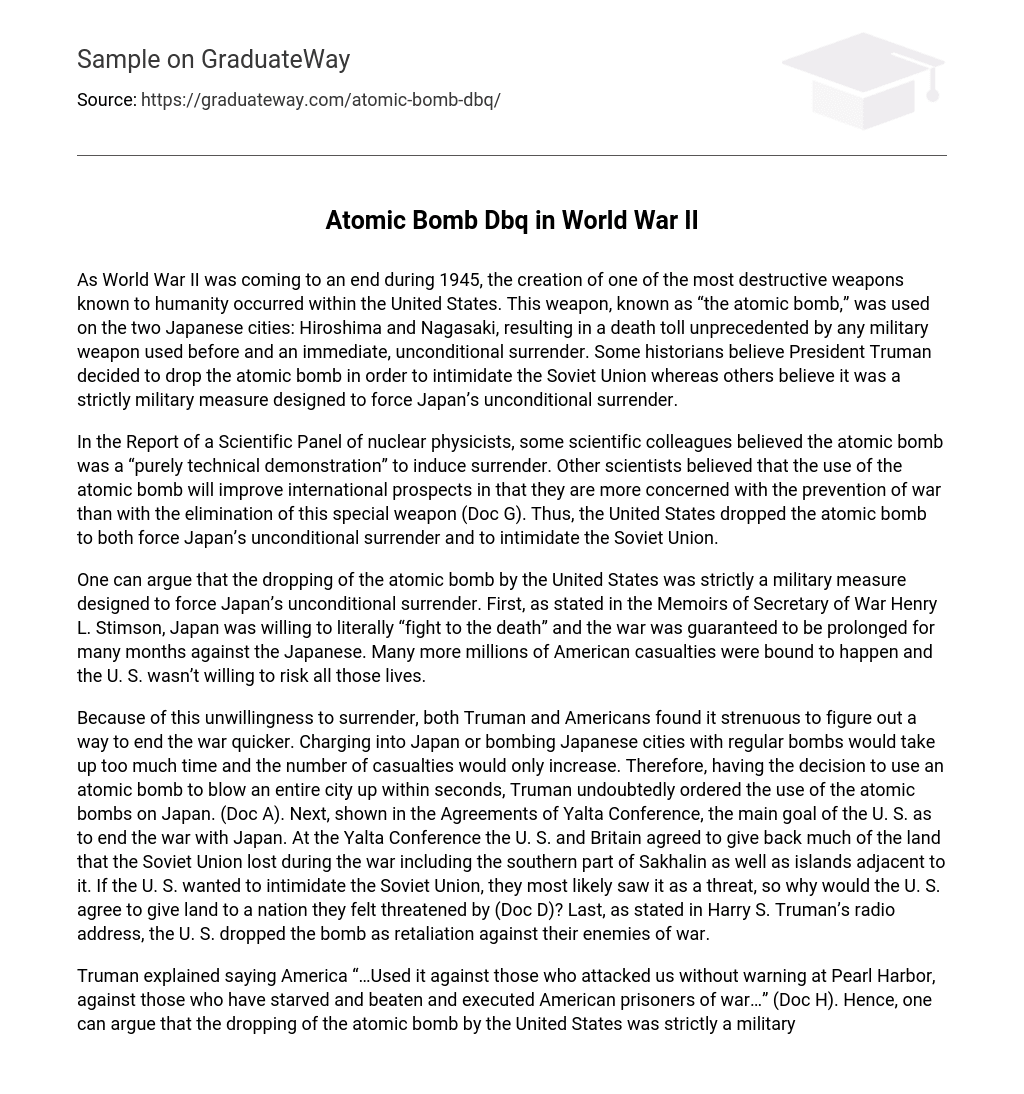In 1945, the United States developed a formidable weapon known as “the atomic bomb” and utilized it on Hiroshima and Nagasaki in Japan. The aftermath was catastrophic, resulting in significant loss of life and ultimately forcing Japan to surrender without any conditions. Historians hold differing perspectives regarding President Truman’s decision to employ the atomic bomb – certain individuals perceive it as a means of intimidating the Soviet Union, while others argue that it was a military tactic intended to compel Japan into an unconditional surrender.
According to a report by a scientific panel of nuclear physicists, there were differing opinions among scientists about the atomic bomb. Some believed it was just a demonstration to force surrender, while others saw it as an opportunity to shift international focus towards preventing wars instead of eliminating weapons (Doc G). Consequently, the United States decided to utilize the atomic bomb to both compel Japan into an unconditional surrender and intimidate the Soviet Union.
According to Secretary of War Henry L. Stimson’s Memoirs, the United States used the atomic bomb as a military strategy in order to force Japan to surrender unconditionally. The memoirs reveal that Japan had a strong determination to continue fighting until the very end, which would have extended the war for several more months. The U.S. was not willing to take this risk, as it would have inevitably led to a significant number of American casualties.
Truman’s decision to not surrender presented challenges for Truman and the American people as they sought a quick end to the war. It was determined that traditional methods like direct attacks or bombings would take too long and result in more casualties. As a result, Truman opted to use atomic bombs, which had the ability to instantly devastate entire cities (Doc A). Additionally, the Yalta Conference Agreements demonstrated that the primary objective of the U.S. was to bring an end to the war with Japan. During this conference, both the U.S. and Britain agreed to return territories lost by the Soviet Union, including Sakhalin’s southern part and its surrounding islands. America may have viewed this concession as a means of intimidating the Soviet Union (Doc D). Lastly, Harry S. Truman stated in his radio address that dropping atomic bombs served as retaliation against their adversaries in the war.
Truman’s clarification revealed that the United States employed the atomic bomb against those who had attacked them at Pearl Harbor and mistreated American prisoners of war. This indicates that the bombing decision was a military tactic intended to compel Japan to surrender unconditionally. However, some argue that it also served as a diplomatic move to intimidate the Soviet Union. General H.H.’s memoirs offer additional understanding on this issue.
During World War II, Arnold, the Commander of the American Army Air Force, held the belief that Japan was on the brink of collapse regardless of whether or not the atomic bomb would be used (Doc B). This belief stemmed from the fact that most Japanese industries had already been destroyed and they were unable to receive crucial supplies for a large-scale war. Dwight Eisenhower, representing President Truman, shared this perspective and opposed seeking Soviet assistance in fighting against Japan. Truman himself believed it would be unfavorable for the United States to rely on help from the Soviets (Doc C). Additionally, Winston Churchill’s account of the Potsdam Conference highlighted the urgency to end the war before any potential Soviet Union intervention.
Documents reveal that the United States and Britain reached an agreement expressing their desire to not depend on the Red Army for concluding the war with Japan. In 1945, nuclear physicist Leo Szilard recollected a meeting where James Byrnes and a group of atomic scientists deliberated over utilizing the atomic bomb as a means to intimidate the Soviet Union. The scientists were apprehensive about Russia’s increasing influence in Europe, which probably impacted America’s containment policy.
James Byrnes and the atomic scientists believed that demonstrating the bomb would have a positive effect due to their fear of the Soviet Union and desire to manage their power in Europe. This belief aligns with John Foster Dulles’ theory of massive retaliation, which suggests that the threat of nuclear weapons would deter Soviet aggression. Therefore, dropping the atomic bomb can be seen as a diplomatic act aimed at intimidating the Soviet Union, supported by containment and massive retaliation theories.
The dropping of the atomic bomb on Hiroshima had two main purposes. One theory suggested that it aimed to force Japan’s quick and unconditional surrender, while another belief was that it served as a warning to the Soviet Union. The use of this powerful weapon by the United States ultimately led to the successful development and testing of an atomic bomb by the Soviet Union in 1949, with assistance from communist spies within America. As a result, intense hostility between these two superpowers emerged, leading to what is known as the Cold War. This period of conflict involved a highly competitive race for arms superiority and numerous nuclear threats, which posed significant risks to both nations’ national security.





